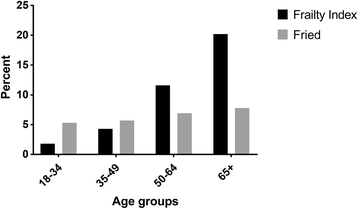Prevalence of frailty in Canadians 18-79 years old in the Canadian Health Measures Survey
- PMID: 28107813
- PMCID: PMC5251297
- DOI: 10.1186/s12877-017-0423-6
Prevalence of frailty in Canadians 18-79 years old in the Canadian Health Measures Survey
Abstract
Background: There is little certainty as to the prevalence of frailty in Canadians in younger adulthood. This study examines and compares the prevalence of frailty in Canadians 18-79 years old using the Accumulation of Deficits and Fried models of frailty.
Methods: The Canadian Health Measures Study data were used to estimate the prevalence of frailty in adults 18-79 years old. A 23-item Frailty Index using the Accumulation of Deficits Model (cycles 1-3; n = 10,995) was developed; frailty was defined as having the presence of 25% or more indices, including symptoms, chronic conditions, and laboratory variables. Fried frailty (cycles 1-2; n = 7,353) included the presence of ≥3 criteria: exhaustion, physical inactivity, poor mobility, unintentional weight loss, and poor grip strength.
Results: The prevalence of frailty was 8.6 and 6.6% with the Accumulation of Deficits and the Fried Model. Comparing the Fried vs. the Accumulation of Deficits Model, the prevalence of frailty was 5.3% vs. 1.8% in the 18-34 age group, 5.7% vs. 4.3% in the 35-49 age group, 6.9% vs. 11.6% in the 50-64 age group, and 7.8% vs. 20.2% in the 65+ age group. Some indices were higher in the younger age groups, including persistent cough, poor health compared to a year ago, and asthma for the accumulation of deficits model, and exhaustion, unintentional weight loss, and weak grip strength for the Fried model, compared to the older age groups.
Conclusions: These data show that frailty is prevalent in younger adults, but varies depending on which frailty tool is used. Further research is needed to determine the health impact of frailty in younger adults.
Keywords: Coss-Sectional studies; Epidemiology; Frailty; Younger age.
Figures
References
MeSH terms
LinkOut - more resources
Full Text Sources
Other Literature Sources


